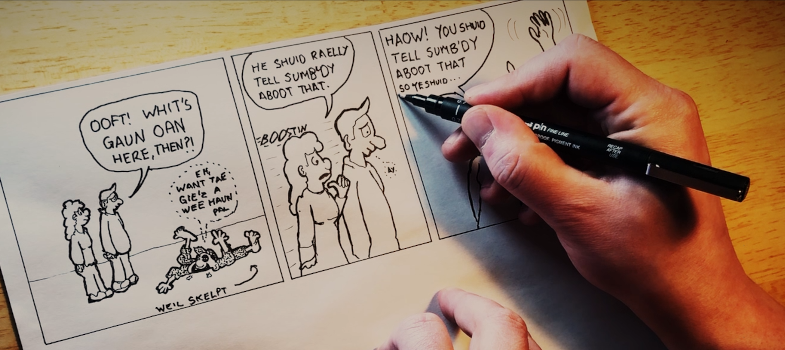Lesson Description:
This lesson was delivered to a mixed ability S4 group towards the end of their completion of the Scots Language Award at level 4-5.
The lesson was designed with a modern languages and literacy focus to help students see Scots as a true modern language with a rich and expressive linguistic heritage. As a modern languages teacher, I used some of the techniques and activities I would usually use when teaching French or Spanish to frame Scots as such. This involved a Scots to Standard English translation starter, and then a main activity working to translate phrases from Standard English into Scots. We finished with an online tarsia game which recapped the language used in the lesson.
How did it go?
I had anticipated that the class would find the starter - translating phrases from Scots to Standard English - quite straightforward, and the main task (where they were basically translating the other way) much more difficult. Put simply, I was wrong! It is difficult to be sure of the reasons for this, and indeed they are probably numerous. Partly, the learners weren’t “warmed up” yet, so were a bit reticent with the first activity - perhaps they knew some of the answers but weren’t comfortable expressing ideas. Perhaps it was because Scots is a language they have mostly encountered orally, and they initially struggled with the transference to written Scots? Further to this, in the second activity they could initially work orally and then transcribe - maybe this was more accessible for the learners. Furthermore, when it came to the main Standard English to Scots activity (which went better than expected), perhaps I have just become more adept at providing suitable supports and resources, and learners are somewhat more trained in where to look to find the words and ideas they need to complete such a task. They also seem to enjoy and be motivated by tasks where there is an element of creative freedom, which some of them found in the translation task - going slightly further away from a literal translation to find something more idiomatic. In any case, this is an interesting comparison to my normal languages classes.
Take-Aways and Next Steps:
Learners seem to be becoming somewhat more confident in expressing themselves in Scots, which is great news. Creative writing seems to be consistently motivating for them, and - perhaps unexpectedly - this group of learners has consistently flourished when tasks have been extended individual tasks (such as this) rather than group work. There was clear transference between this lesson and French / Spanish / German lessons, and a number of literacy benchmarks were met; I have plans for a full BGE “Scots and Literacy” course in future and I could really see how this sort of task could be used to both ends. There is still significant nervousness around their work being shared or speaking Scots “straight” (without a comic intention, for example), and learners still need exposure to a far wider range of Scots texts and media. We can build this in within our department, but I also have some ideas to encourage other staff to get in on the Scots game! The main next steps for most learners, though, are increasing their Scots vocabulary and increasing their confidence in their spoken Scots (one may well lead to the other). Finally, doing more activities which mirror the activities I do in a “normal” languages classrooms certainly seems to help frame Scots as a “true” language so I would like to do much more of this approach going forward. There is a competitive pronunciation game I often play which I’d like to try, for example.
